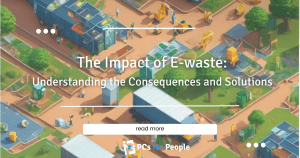 E-waste is electronic waste that includes discarded electronic devices. It is one of the fastest-growing waste categories globally, with 53.6 million metric tons generated in 2019, and only 17% of this E-waste is properly recycled. E-waste is expected to double by 2050 if no action is taken.
E-waste is electronic waste that includes discarded electronic devices. It is one of the fastest-growing waste categories globally, with 53.6 million metric tons generated in 2019, and only 17% of this E-waste is properly recycled. E-waste is expected to double by 2050 if no action is taken.
Improper e-waste management has environmental and health impacts, particularly in developing countries where informal recycling sectors use hazardous chemicals. These chemicals pose significant environmental risks, including soil and water sources, and can negatively affect the health of women and children exposed to toxic environments. Additionally, improper E-waste management contributes to greenhouse gas emissions, exacerbating climate change. To address this issue, we must establish a sustainable E-waste management system and embrace a circular economy with higher recovery and recycling rates. As consumers, we can extend the life of our electronic devices by repairing and recycling them whenever possible. At the same time, producers should prioritize designing products for durability, ease of repair, and recyclability. Governments must support initiatives to reduce E-waste and safeguard informal workers from hazardous waste risks.
The issue of e-waste is a growing concern, and it’s expected to double to around 111 million tons per year by 2050. We need to take action to address this issue and find sustainable solutions to minimize the harmful effects of e-waste on our planet. Businesses and individuals can take responsibility for their electronic waste and work towards reducing the amount of e-waste.
The issue of e-waste is not just about the quantities alone but about the actions taken by industries, policies, and consumers. While there is potential to create sustainable production and consumption systems for electronics, this cannot be achieved by continuing with current business practices. The electronics sector needs to evolve to meet the growing demand and keep pace with technological advancements. Although new technologies are emerging to improve the energy efficiency and portability of electronics, recycling these materials has been challenging. Despite the availability of technology, there is often no economic incentive for recycling materials from e-waste. Additionally, policies and regulations to cover e-waste have not yielded the expected results, and collection rates of e-waste are still lagging at around 20% globally. As a result, a significant amount of e-waste generated is not properly treated.
Businesses in the electronics sector can take responsibility and lead the way towards a more circular economy. Depending on the response, the future of e-waste can be imagined in three scenarios.
- The linear growth scenario, the business-as-usual approach, may result in short-term affordability of electronic products. Still, it will not be free from long-term costs such as environmental footprints and toxicity. Without improvements in collection and recycling technologies, advancements in production alone will not close the production and consumption cycles.
- In a reactive approach scenario, where the industry is forced to comply with stricter regulations, the e-waste situation may improve locally, but the impact will be outsourced to countries with weaker environmental regulations. This will increase the chance of informal activities, and compliance costs being transferred to consumers.
- The best alternative is a proactive path, where industry players lead towards more sustainable production and consumption. Manufacturers can prioritize lifetime extension and reuse of electronic products through innovative business models. This shift towards circular business practices will reduce the negative impacts of e-waste and prevent e-waste generation despite the inevitable growth in electronics.
While it’s difficult to predict technological evolution, the use of electronics and the generation of e-waste will almost certainly grow in the coming decades, especially in rapidly growing economies. This means there will be more challenges and opportunities for all players in the global e-waste arena, including producers, users, e-waste collectors, recyclers, and policymakers. A sustainable production and consumption system for e-products will require significant efforts from all stakeholders.
The Solving the E-waste Problem Initiative is an independent network of e-waste experts and a multi-stakeholder platform that develops strategies to address all electronics dimensions in an increasingly digitized world. The Initiative uses an integrated and science-rooted approach to create solutions to global e-waste challenges throughout the entire lifecycle of electronics. The Sustainable Cycles (SCYCLE) Program, hosted by the United Nations University, aims to promote sustainable societies and develop sustainable production, consumption, and disposal patterns for electrical and electronic equipment and other goods. SCYCLE is a leading voice in the global e-waste discussion and advances sustainable e-waste management strategies based on life-cycle thinking. Download the Report (pdf): https://collections.unu.edu/
Through our commitment to digital literacy, PCs for People has made a meaningful impact on the lives of 140,000 individuals, providing them with refurbished computers, internet access, and digital skills training. Our efforts to bridge the digital divide are genuinely inspiring and remind us of the importance of empowering individuals with the tools they need to succeed in today’s world.
Help us continue to close the digital divide!



